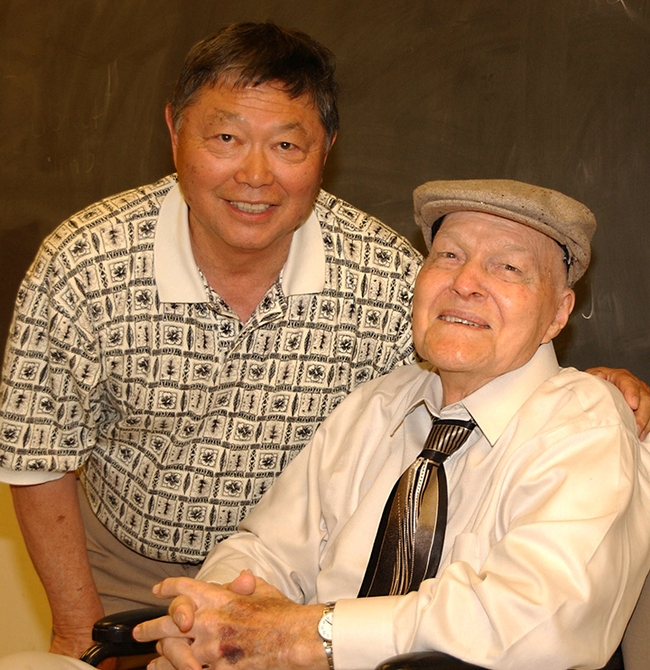- Author: Kathy Keatley Garvey
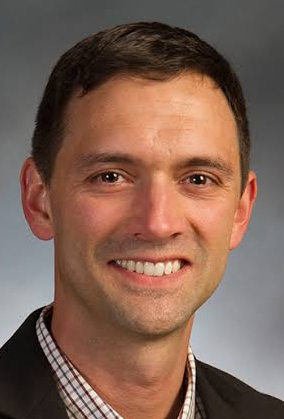
Associate professor Kyle Wickings of the Department of Entomology and Nematology, New York State Agricultural Experiment Station, Cornell University, will speak on “Composition and Function of Soil Invertebrate Communities in Residential Greenspaces” at 4:10 p.m., Monday, Sept. 30 in 122 Briggs Hall.
This is the first in a series of fall seminars hosted by the UC Davis Department of Entomology and Nematology and coordinated by nematologist Amanda Hodson, assistant professor.
“Turfgrasses cover a significant portion of U.S. land area and are used for a variety of cultural and other ecosystem services," he says in his abstract. "However, this service provisioning capacity varies tremendously by geographic location and management context. In this seminar, I will present research from my program on the potential or turfgrasses to serve as reservoirs for belowground biodiversity and soil organic matter in residential laws and public parks o the northwestern United States. I will also discuss the consequences of turfgrass cultural and pest management practices or soil biological communities and processes.”
His seminar will be broadcast on Zoom and archived. The Zoom link:
https://ucdavis.zoom.us/j/95882849672.
On his website, Wickings relates: "My research strives to understand the interactions between arthropods, microbes, and soil organic matter, and how these interactions may be modified to improve plant protection in the rhizosphere. One of my research goals is to identify underlying characteristics of soil organic matter (quantity, quality, and composition) which influence root herbivore populations. This knowledge could improve our ability to predict pest outbreaks and may ultimately be used to develop soil amendments which suppress root-feeding pests. I am also interested in understanding the role that soil microbes play in the nutritional ecology of root-feeding arthropods. My previous research demonstrates that soil arthropods interact closely with microbes during feeding, and it is well known that soil arthropods form diverse external and internal associations with microbes. My research at Cornell will continue in this area to improve our understanding of the role of microbes in root herbivore nutrition and the potential for managing root-feeding pests by influencing the soil microbial community."
Wickings, who joined the Cornell University faculty in 2013, holds a bachelor of science degree in environmental studies, summa cum laude (2001), and a doctorate in 2007 in ecology from the University of Georgia Odum School of Ecology. His dissertation: “Arthropod Biodiversity in a Georgia Cotton Agroecosysem: Cotton, Tillage, Cover Crops and Red Imported Fire Ants."
He did postdoctoral research from 2010-2013 for the Department of Natural Resources, University of New Hampshire, Durham, where he conducted research on the effects of management intensity on soil biota and their role in long-term decomposition; performed advanced chemical analysis of soil and plant residue for collaborative research projects; and advised graduate students studying symbiotic microbes of soil invertebrates and patterns of microarthropod distribution in soils.
He earlier served as a postdoctoral associate (2006-2010) for the Department of Crop and Soil Sciences, Michigan State University, East Lansing.
Wickings has authored or co-authored research published in PloS One, Ecology Letters, Peobiologia, Soil Biology and Biochemistry, and Annals of the Entomological Society of America, among others.
Wickings received Cornell's 2017 Early Achievement Award for his work researching the effects of soil arthropods and microbes on plant health and chemistry.
The full list of the department's fall seminars is here. For more information or for technical issues, contact Hodson at akhodson@ucdavis.edu.
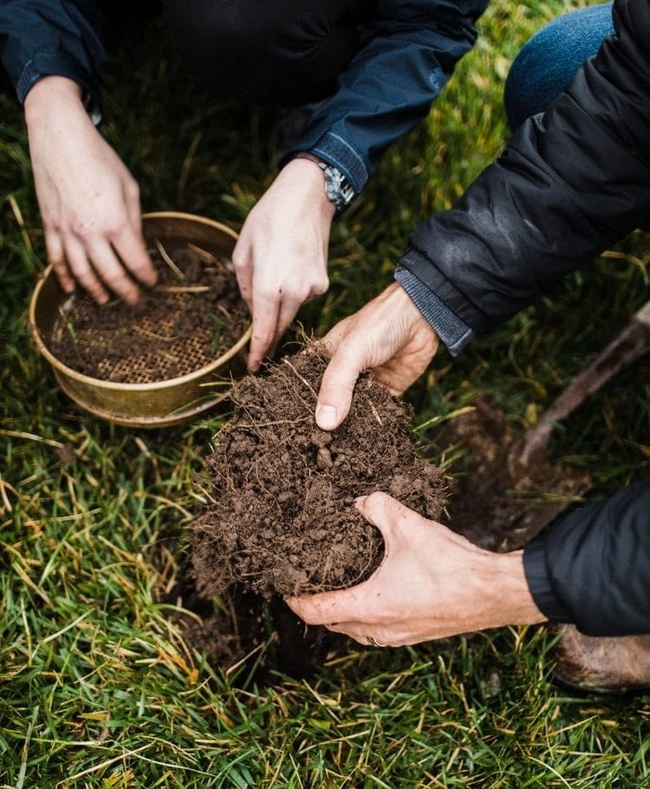
- Author: Kathy Keatley Garvey
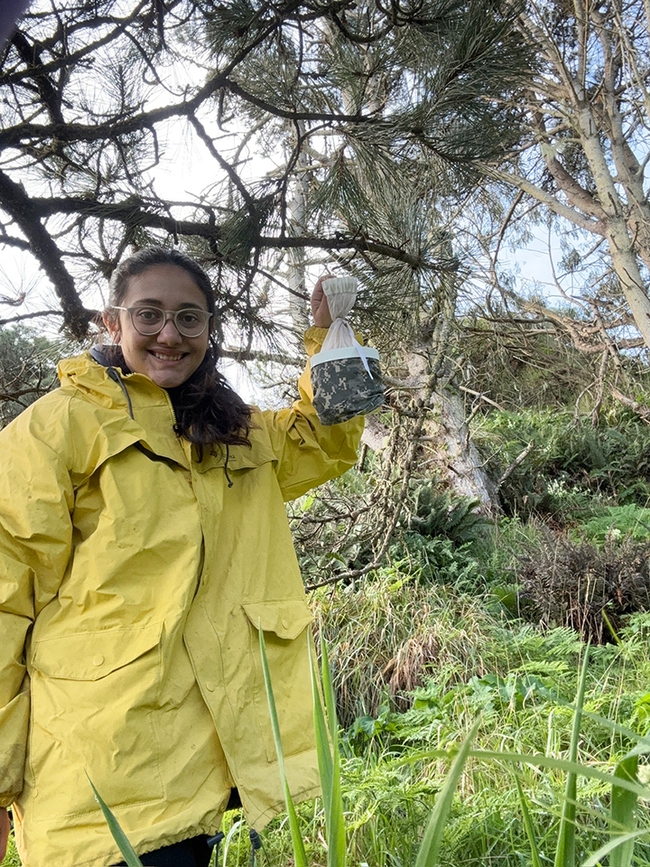
UC Davis doctoral student and medical entomologist Carla-Cristina “CC” Melo Edwards of the laboratory of medical entomologist-geneticist Geoffrey Attardo of the UC Davis Department of Entomology and Nematology, will be discussing mosquitoes and ticks--and how she traps them--when the Bohart Museum of Entomology hosts an open house on Saturday, Sept. 28.
Edwards will be among the scientists discussing and displaying their work and fielding questions.
The open house, themed "Museum ABCs: Arthropods, Bohart and Collecting," and free and family friendly, takes place from 1 to 4 p.m. in Room 1124 of the Academic Surge Building, 455 Crocker Lane, UC Davis campus. Parking is also free.
The event will be "an overview of terrestrial arthropods which encompasses everything from insects, arachnids, millipedes, isopods and centipedes," said Tabatha Yang, education and outreach coordination. "We will also showcase some of the trapping/catching methods we use, for example, nets, lights, pitfall traps and malaise traps."
"We also get asked a lot of questions about our own collection and why the specimens don't decay," Yang added. "We will highlight the different curation techniques from pinning, point mounting, preserving in alcohol and mounting on slides."
Edwards said she will discuss and showcase "different kinds of traps that we use for mosquitoes and ticks...Different types of mosquitoes require different types of traps!"
Her doctoral research focuses on investigating the physiological mechanisms underlying pyrethroid resistance in Aedes aegypti (the yellow fever mosquito). She was a McNair scholar at Baylor University, where she completed her undergraduate degree in cell and molecular biology in May 2021.
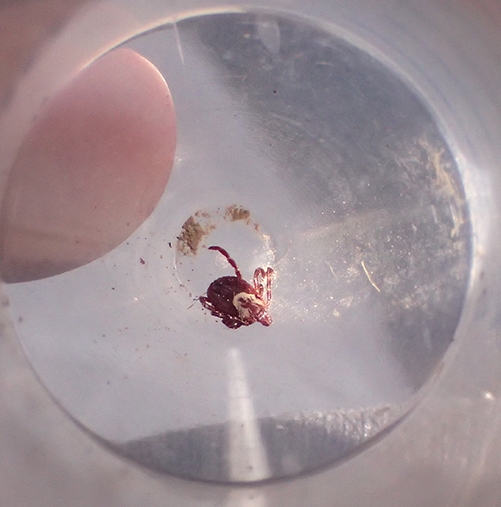
Luz Maria Robles, public information for the Sacramento-Yolo Mosquito and Vector Control, says the risk of contracting West Nile virus in Sacramento and Yolo counties continues. (See map of latest West Nile virus activity in the two counties.) This year, to date, the statistics show:
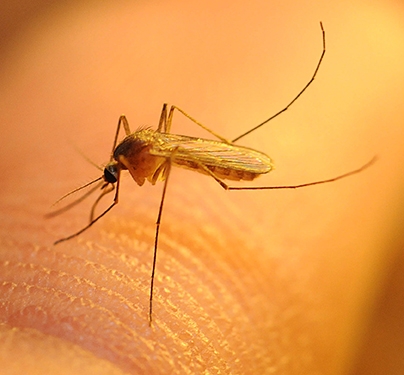
Yolo County: 1 dead bird and 42 mosquito samples have tested positive for West Nile virus
In addition to featuring the science of entomology, the Bohart open house will include a tribute to the late UC Davis professor Richard "Doc" Bohart (1913-2007), who founded the insect museum in 1946; served as the first director; and compiled 32 years on the UC Davis entomology faculty, Sept. 28 is his birthday anniversary and a cake to celebrate what would have been his 111th birthday will be served.
UC Davis distinguished emerita professor Lynn Kimsey, who directed the Bohart Museum for 34 years, retiring on Feb. 1, 2024, was Bohart's last graduate student. She remembers him in the audio of a newly produced video by Walter Leal, UC Davis distinguished professor of molecular and cellular biology and former chair of the UC Davis Department of Entomology. Kimsey provides the narrative and images. Leal added excerpts from a 1996 Aggie Video production when Kimsey interviewed Bohart. (See https://youtu.be/3YqnK-CpbJE)
The Bohart Museum is the home of a global collection of eight million insect specimens. It also houses a live petting zoo (Madagascar hissing cockroaches, walking sticks, tarantulas and more) and an insect-themed gift shop, stocked with t-shirts, hoodies, books, posters and jewelry, among other items. Director is Professor Jason Bond, the Evert and Marion Schlinger Endowed Chair, UC Davis Department of Entomology and Nematology, and associate dean, UC Davis College of Agricultural and Environmental Sciences.
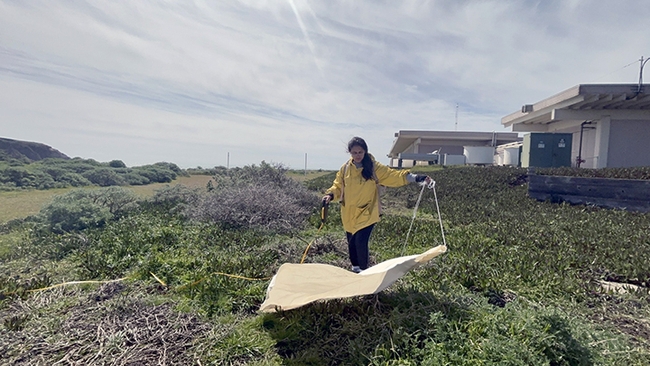
- Author: Kathy Keatley Garvey
Praying, preying, or peering?
This female praying mantis, a Stagmomantis limbata, selects a patch of red Lantana to watch for pollinators.
Her spiked forelegs resting, her eyes always watching but her body as still as a stone, she makes an incredible predator portrait. That triangular head, those bulging eyes, that pencil-thin "neck."
Her common names included "bordered mantis, bosque mantis, Arizona mantis, and New Mexico praying mantis." This species is native to North America and considered most prevalent in the southwestern United States.
What's for breakfast? A bee, a butterfly, a syrphid fly?
What's for lunch? What's for dinner? What's for snacks?
She need not worry. She's a great ambush predator.
A limbata in the Lantana.
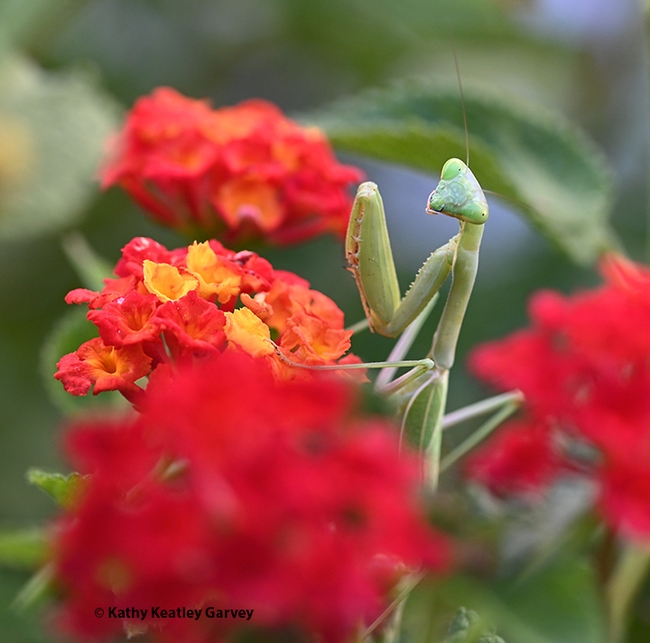
- Author: Kathy Keatley Garvey
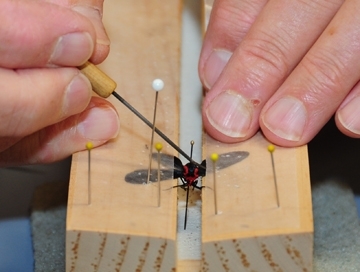
It's not as easy as it looks, but entomologist Jeff Smith, curator of the Bohart Museum of Entomology's Lepidoptera collection, makes it look easy.
If you attend the Bohart Museum open house, set from 1 to 4 p.m., Saturday, Sept. 28 in Room 1124 of the Academic Surge Building, 455 Crocker Lane, UC Davis campus, you'll learn how he does it.
Indeed, it is no easy feat to pin a butterfly or moth. Just ask research entomologist Tom Zavorink, a Bohart Museum associate.
"Personally, I am astounded by the thousands upon thousands of butterflies and moths that Jeff has prepared for display or scientific study," Zavorink told us back in 2015, when the UC Davis College of Agricultural and Environmental Sciences selected Smith for its Friend of the College Award.
"This is no small task," Zavortink said, "because butterfly and moth specimens are usually brought from the field in envelopes or boxes with their wings folded over their backs or around their bodies, and preparing them for display or scientific study involves relaxing them in a humid chamber so their wings and legs can be manipulated, carefully spreading open the wings, positioning them on a flat surface, and securing them in that position until the specimen dries again. This is an onerous task that many entomologists, myself included, shun because we don't have the time, manual dexterity, or patience it takes to prepare quality specimens."

A Bohart volunteer since 1998, Smith has spread the wings of some 180,000 moths and butterflies, typically 6,000 or more each year for the past 30-plus years. He has crafted and donated some 2,475 wooden specimen drawers, including 110 so far this year. He also has donated some 100,000 specimens (primarily butterflies, moths but a few other insects, including beetles) to the Bohart Museum.
The Lepidoptera collection now totals about 750,000 specimens. Lately Smith has been redoing the header labels in the unit trays for much of the Lepidoptera collection, "making the new ones in the better format where the geographic ranges of the various species and subspecies are on the label. This is so helpful when it comes to placing new material into the collection."
When Smith received the Friend of the College award, Bohart director Lynn Kimsey, now UC Davis distinguished professor emerita, said: “You could not ask for a better friend than Jeff Smith. He has brought us international acclaim and saved us $160,000 through donations of specimens and materials, identification skills and his professional woodworking skills. This does not include the thousands of hours he has donated in outreach programs that draw attention to the museum, the college and the university.”
“When Jeff was working for Univar Environmental Services, a 35-year career until his retirement in 2013, he would spend some of his vacation days at the museum. Over the years Jeff took over more and more of the curation of the butterfly and moth collection. He took home literally thousands of field pinned specimens and spread their wings at home, bringing them back to the museum perfectly mounted."
Smith engages in public outreach at the Bohart Museum's open houses, which include open houses with various themes, plus UC Davis Picnic Day, UC Davis Biodiversity Museum Day, and Take-Your-Daughters-and-Sons-to-Work Day. In addition, Smith annually presents an evening spreading class to the UC Davis Entomology Club as well as an annual presentation to Bio Boot Camp. He also speaks at 12 to 15 other venues per year, engaging students at School Science Days and in individual classrooms.
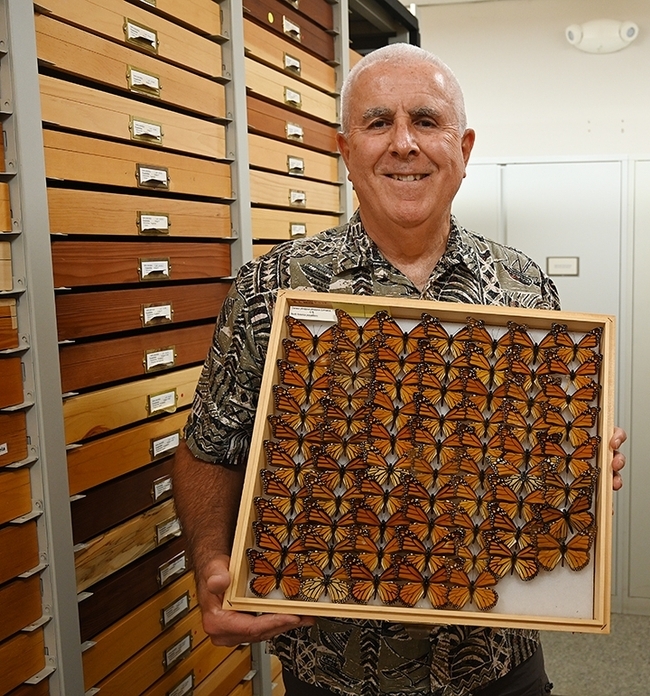
"We will have an overview of terrestrial arthropods which encompasses everything from insects, arachnids, millipedes, isopods and centipedes," said Tabatha Yang, education and outreach coordination. "We will also showcase some of the trapping/catching methods we use, for example, nets, lights, pitfall traps and malaise traps."
"We also get asked a lot of questions about our own collection and why the specimens don't decay," she added. "We will highlight the different curation techniques from pinning, point mounting, preserving in alcohol and mounting on slides."
Also planned is a tribute to the late UC Davis professor Richard "Doc" Bohart (1913-2007), who founded the insect museum in 1946, served as the first director, and compiled 32 years on the UC Davis entomology faculty, Sept. 28 is his birthday anniversary and a cake to celebrate what would have been his 111th birthday will be served.
Kimsey, his last graduate student, remembers him in the audio of a newly produced video by Walter Leal, UC Davis distinguished professor of molecular and cellular biology and former chair of the UC Davis Department of Entomology. Kimsey provides the narrative and images. Leal added excerpts from a 1996 Aggie Video production when Kimsey interviewed Bohart. (See https://youtu.be/3YqnK-CpbJE)
Luz Maria Robles, public information for the Sacramento-Yolo Mosquito and Vector Control, says the risk of contracting West Nile virus in Sacramento and Yolo counties continues. (See map of latest West Nile virus activity in the two counties.) This year, to date, the statistics show:
Sacramento County: 53 dead birds and 46 mosquito samples have tested positive for West Nile virus
Yolo County: 1 dead bird and 42 mosquito samples have tested positive for West Nile virus
The Bohart Museum houses a global collection of eight million insect specimens. It also is the home of a petting zoo (Madagascar hissing cockroaches, walking sticks, tarantulas and more) and an insect-themed gift shop, stocked with t-shirts,hoodies, books, posters,jewelry, stuffed animals, and insect collecting equipment.Museum director is professor and arachnologist Jason Bond, the Evert and Marion Schlinger Endowed Chair in Insect Systematics, UC Davis Department of Entomology and Nematology, and associate dean of the UC Davis College of Agricultural and Environmental Sciences.
For more information, contact bmuseum@ucdavis.edu.
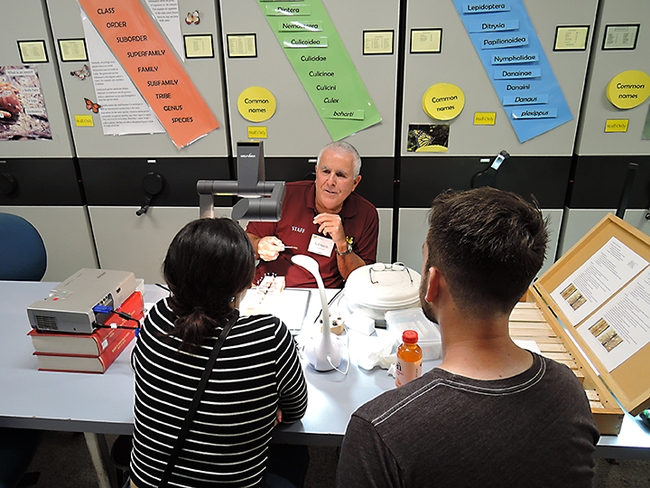
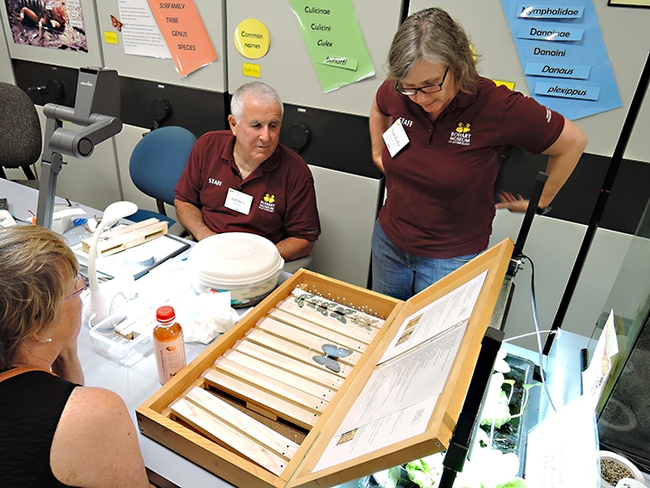
- Author: Kathy Keatley Garvey
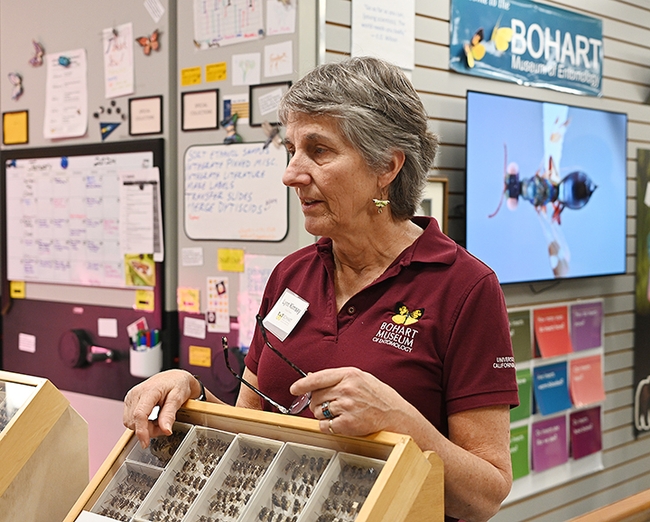
It's the birthday anniversary of noted entomologist Richard "Doc" Bohart (1913-2007), founder of the Bohart Museum of Entomology, University of California, Davis.
So when the Bohart Museum hosts a public open house (theme:"Museum ABCs: Arthropods, Bohart and Collecting") from 1 to 4 p.m., Saturday, Sept. 28, plans also call for a tribute to him and his work.
"Doc" Bohart founded the insect museum in 1946 and served as its first director; compiled 32 years on the entomology faculty; and became an internationally recognized entomologist and author.
Born Sept. 28, 2013 in Palo Alto, Richard began collecting butterflies at age 7. "He and his brother George 'Ned' Bohart collected butterflies for a local collector to earn pocket money," according to UC Davis distinguished professor emerita Lynn Kimsey, who directed the Bohart Museum for 34 years until her retirement on Feb. 1, 2024.
Bohart attended UC Berkeley, receiving three degrees in entomology culminating in his doctorate in 1938. He joined the UC Davis faculty in 1946 and chaired the Department of Entomology from 1956 to 1965. He taught general entomology, medical entomology, systematics, and agricultural entomology.
According to the Academic Senate's memorial, Bohart "contributed substantially to the world literature of the insect Order Hymenoptera, which included two landmark books, Sphecid Wasps of the World (with A. S. Menke), and The Chrysidid Wasps of the World (with L.S. Kimsey), as well as 230 journal articles and four other books on wasps and mosquitoes, including the second and third editions of The Mosquitoes of California (the second with Stanley B. Freeborn and the third with Robert K. Washino). During his career, he described more than 200 new species and genera of insects."
Today the Bohart Museum is the home of a global collection of eight million insects; a live petting zoo (including Madagascar hissing cockroaches, stick insects and tarantulas); and an insect-themed gift shop, stocked with T-shirts, hoodies, jewelry, books, posters, and collecting equipment. The new director, only the third since 1946, is Professor Jason Bond, the Evert and Marion Schlinger Endowed Chair in Insect Systematics, UC Davis Department of Entomology and Nematology, and associate dean of the UC Davis College of Agricultural and Environmental Sciences.
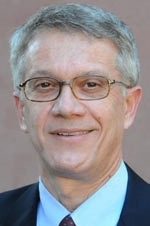
"His teaching and collecting activities resulted in the development of one of the finest collections of stinging wasps in the world in the Bohart Museum of Entomology," Kimsey said. "A great deal of this material was obtained through his collecting and that of his students. During his tenure, the museum collection grew from 500 specimens to 7 million, a span of some 60 years. Chancellor James Meyer dedicated the entomology museum in his name in 1983. The R. M. Bohart Museum moved into a new building in 1994 and was dedicated by Chancellor Larry Vanderhoef."
Open House. The open house, free and family friendly, will include "an overview of terrestrial arthropods which encompasses everything from insects, arachnids, millipedes, isopods and centipedes," said Tabatha Yang, education and outreach coordination. "We will also showcase some of the trapping/catching methods we use, for example, nets, lights, pitfall traps and malaise traps."
Pinning, spreading and curation demonstrations are planned "so people know how to take care of and preserve a dead arthropod for research or for a personal collection," Yang said. "People sometimes find a dead dragonfly or a butterfly on the ground and we often get asked how they can preserve it."
"We also get asked a lot of questions about our own collection and why the specimens don't decay," she added. "We will highlight the different curation techniques from pinning, point mounting, preserving in alcohol and mounting on slides."
Entomologist Jeff Smith, curator of the Lepidoptera collection, which encompasses some 750,000 specimens, will demonstrate and discuss the various steps of relaxing, pinning, spreading, and labeling moths and butterflies.
A Bohart volunteer since 1998, Smith has spread the wings of some 180,000 moths and butterflies, typically 6,000 or more each year for the past 30-plus years. He has crafted and donated some 2,475 wooden specimen drawers, including 110 so far this year. He also has donated some 100,000 specimens (primarily butterflies, moths but a few other insects, including beetles) to the Bohart Museum.
